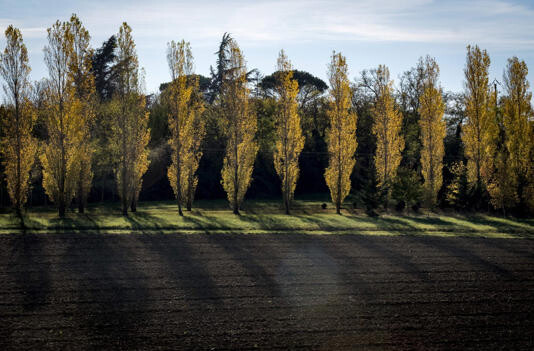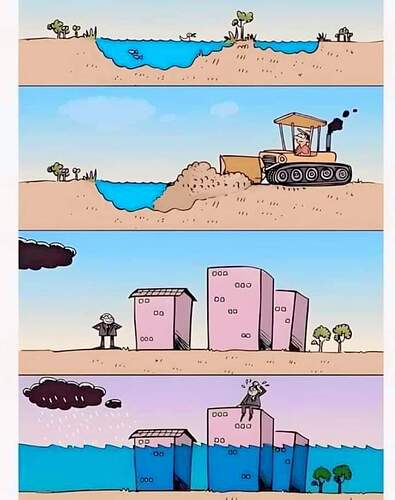Ummm!!! Hello?? Over here!!!

A good deal of the UK is as well. It is very common for flood plains to be built on as the land is cheap. Mainly because it floods.
Flat ground making house construction cheaper, also nice locations near a watercourse.
So nice watching the turds float by and walking by the trees decorated with bog roll.
Hurricane season hitting earlier in the States. Hurricane Debby going right up the gulf coast where we were on holiday just a few weeks ago. Only a category one, but still very damaging, especially the storm surges.
Some of those places were hit last year and while hurricanes have always been a fact of life, the frequency, intensity, and length of season, are all going up.
Probably one for the climate change thread. The changes are very obvious, and it is astonishing to me that there are still many climate change deniers.
Someone at work mentioned that the season following El Nino is stormy. I’ll have to get back to him on what the effect was again.
Well we got Suarez and Carroll, but Suarez kept hitting the post and Carroll…
Not to mention Downing and Adams, what a disaster.
I hate articles based on social media. Who gives a shit about that far-right cesspit?
Guaranteed there’s an idiot somewhere that says this is the difference between summer and winter.
Idiocy reigns
Two-three years ago, I went to the glacier of Aletsch, the biggest one in Europe. I hadn’t been there in fifteen-twenty years, and was exactly as struck by the massive change. The length of the glacier was at least reduced by 1’000 metres, but more importantly, the height of the ice mass was reduced by around ten meters! It was a frightening sight to be honest.
Something positive for a change:
Pity they’re all being cut down.
Of course, that doesn’t absolve in any way, shape or form, mankind of having to behave more responsibly.
But I find it fascinating how adaptative life is, and especially vegetal life. It was already known that young trees grow faster when having more CO2 in the atmosphere, but apparently, old forests find also ways to absorb more CO2, and to thrive on it.
Bottom-line: vegetal life (and especially big old forests) is looking for balancing things out, it’s our very best ally in order to survive. Without it, we disappear in an instant. So, we certainly should help it to help us, instead of destroying it further.
While this is undoubtebly great it also bugs me. My reason is that the major ignorance to climate change i see is the 0.01% increase (they always quote percentages rather than PPM) is minor and plants love it. This feeds that grossly misaligned perspective.
A type of nature versus science slippery slope oxymoron, or not ![]()
Genetically engineered ‘super wood’ absorbs more carbon and reduces emissions

Scientists have developed a new method for producing a “super wood” that stores more carbon and reduces emissions, thanks to a ground-breaking genetic modification.
The modified wood could also offer a more sustainable, durable and cost-effective alternative to traditional building materials
Researchers at the University of Maryland genetically modified poplar trees to lower their lignin content by 12.8 per cent. Lignin is a key component that makes wood durable but complicates its processing.
By reducing lignin, the wood can be directly used for high-strength applications without chemical treatment. This not only simplifies the production process but increases the wood’s ability to store carbon, researchers said in a study published in the journal Matter on Monday.
“Our method not only reduces chemical waste and energy consumption, but also improves the wood’s carbon storage capabilities, which is crucial for mitigating climate change,” Prof Yiping Qi, one of the researchers, said.
The genetically modified wood resists decay better, allowing it to store carbon for a longer time. This means less carbon dioxide is released into the atmosphere, contributing to a reduction in overall carbon emissions.
Traditional wood, often processed with chemicals, tends to deteriorate quickly.
In addition to its carbon storage benefits, the new method reduces emissions associated with wood processing, researchers said.
Traditional wood needs significant energy and chemical inputs, which result in greenhouse gas emissions and chemical waste. The new approach eliminates these processes, making production of high-performance wood more environment friendly.
Researchers tested their genetically modified poplars alongside unmodified ones in a greenhouse for six months and found no significant differences in growth or health. They then produced compressed wood samples from the modified trees that are used in furniture and construction.
This compressed wood performed just as well as chemically treated wood, being more than 1.5 times stronger than untreated wood and as strong as aluminium alloy 6061, a material commonly used in various engineering and construction applications.
Poplar trees, known for rapid growth and widely used in the timber and paper industries, have been genetically modified by other researchers in the past.
In 2023, Living Carbon, a San Francisco-based biotechnology company, planted the first batch of genetically modified poplars in the United States outside of a research trial or a commercial fruit orchard.
Wood bicycles are finally coming!
:0)

Thats a surprising standpoint

